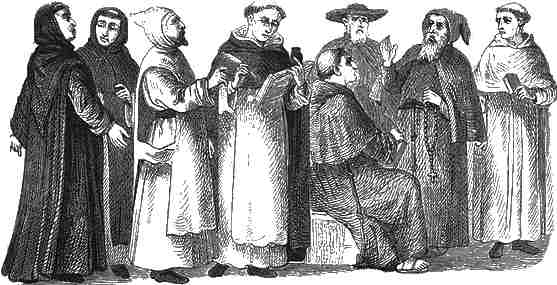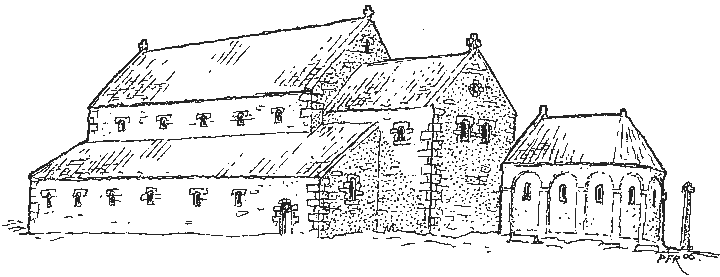
a Benedictine, a Cistercian, a Carthusian, a Dominican, a Franciscan, an Augustinian, a Capuchin, and a Premonstratensian
‘What IS an abbey?’ visitors ask. Does it differ from a priory? Is this place a church, or a cathedral? Was it a monastery? Does the name ‘Hexham’ mean something? Is it ‘Church of England’?

[above] The Hagustaldian Church and Cathedral, 7th–9th centuries by Peter Ryder;
[below] the Priory Church, 13th–15th centuries by Neville Hadcock.

Our church, to give its full name, is:
HEXHAM ABBEY
The Priory and Parish Church of St Andrew
BRIEFLY:
ABBEY is a general term for any place occupied by monks or nuns, now or in former times. Though MONASTERY means much the same, it usually has monks only. A PRIORY is a smaller abbey, or a house for canons. A CONVENT is any home for a religious community, often for nuns. Each of these words covers both the community and the group of buildings they occupy, and for each the CHURCH is their focal point. Both MONKS and NUNS live secluded from the world, devoting themselves to prayer and godly work. CANONS are ordained priests, but some (like the Augustinian canons at Hexham) live and pray together. All religious living together like this must obey a strict RULE (Latin, regulus) and so are called REGULARS. Clergy who live and work in the lay community are SECULAR. A PARISH CHURCH serves not a closed religious community but all the people of a district, a village or town. A CATHEDRAL is the principal church of a bishop, who oversees the parishes of his DIOCESE.
Since St Wilfrid dedicated his new church to St Andrew, over thirteen centuries ago, it has been known by many different names.
Bede, who wrote his Ecclesiastical History of the English People (in Latin) in 731, knew Wilfrid and his church. He always called it Ecclesia Hagustaldensis, as did everyone for its first six or seven centuries. The name is usually translated as ‘Hexham Abbey’, as that is what the church became. Bede was referring not just to the church building but to the whole community serving it.
Ecclesia Hagustaldensis translates literally as ‘The Hagustaldian Church’. ‘Hagustald’ in Old English meant ‘a landless warrior, a younger son’. The land where Wilfrid built his church was known as Hagustaldes-ea, the ‘Hagustald's Island’ or ‘Hagustald's Land’. The ‘landless warrior’ may have been Prince Oswiu, later King of Northumbria, whose daughter-in-law Queen Æthilthryth gave the land to Wilfrid. This large district may be the later Hexhamshire, and was rich enough to support Wilfrid's church and all the people who served it.
The Hagustaldian Church was probably served by monks, who obeyed the Rule of St Benedict (which Wilfrid had brought from Italy), so it could be described as a monastery. There were many others who served the Church: secular clergy, craftsmen, smiths, farm-workers and their families. Homes and workshops, large and small, spread around the stone church.
Monastery comes from a Greek word, meaning to live alone. Hermits, having left the busy world to devote themselves to prayer, found they could live as solitaries in a monastic community, so long as all obeyed the Rule. The same Greek word, which became monasterium in Latin, produced another English word ‘minster’, for a large church with clergy serving a wide area. Perhaps St Wilfrid's church was what we would call a minster rather than, or as well as, a monastery in the strict sense, with priests and canons as well as monks.
Some monasteries were called ‘Abbeys’ because they were headed by an Abbot, or ‘Father’. The word was originally abba in the Aramaic language. There is no mention of an abbot ruling the Hagustaldian Church. Instead it became a cathedral, so called because the bishop's throne was a cathedra. Archbishop Theodore made Hexham the seat of a bishop in 678 when he broke up the large diocese of York, so it became an administrative centre with authority stretching from the Coquet to the Tees. The stone cathedra survives in the present church.

a Benedictine, a Cistercian, a Carthusian, a Dominican, a Franciscan, an Augustinian, a Capuchin, and a Premonstratensian
The Hagustaldian Church survived for many centuries, though it ceased to be a cathedral about 821 and its monks disappeared about the same time. A family of priests served it, father succeeding son. By the 12th century the community around the Church had a name of its own: ‘Hagustaldes-ham’ it was at first, then ‘Hextildesham’, the township of Hextilda. The name of a Tynedale noblewoman and benefactress of the Church replaced one whose meaning had been forgotten.
By that time the church had been separated from the town around it. The Normans brought in continental ideas about reviving and reforming religious life. Clergy were to be totally dedicated to worship, and to live apart from the lay folk they served as celibates. In the 12th century the Norman Archbishop of York sent Augustinian canons to restore the Church at Hexham. One of their first actions was to enclose their buildings with a high wall, and their wall helped to shape the town growing outside it.
At most 26 canons lived around the cloisters at Hexham, working as parish priests, teachers and carers. Officially, they were The Prior and Convent of Hextildesham, though we usually speak of Hexham Priory. Prior is simply Latin for ‘before’ or ‘foremost’, and in a large monastery or a cathedral the prior led the monks as deputy to the abbot or bishop. In a smaller house of monks or canons he was himself at the top of the tree, so it became a priory. Convent is from the Latin for ‘come together’, or ‘assembly’. The canons were also priests; they owned property, including one ‘little piece of land’ that became ‘Priestpopple’. There were at Hexham no friars, dedicated travelling preachers who lived by begging.
The Priory Church served also as parish church for the people of Hexhamshire, though St Mary's Chapel stood just outside the priory wall. The pulpitum screen enclosing the canons' quire still divides the present Abbey.
In the 1530s Henry VIII broke the links between England and the Roman Catholic Church. The Reformation made him head of a new ‘Church of England’. Because Henry suspected them of treason and coveted their wealth, all monks and canons regular were expelled, while protestant reformers destroyed images and windows. After the Dissolution all the Priory's properties in and around Hexham passed to the king's supporters, and later to the families who held the Lordship of the Manor of Hexham. Carnabys, Fenwicks, Blacketts, and Beaumonts in turn occupied the former priory buildings and made their homes where prior and canons had once lived. They allowed Hexham people to carry on using the former priory church as their parish church.
By the 18th century people showed new interest in the Middle Ages. The centuries since the fall of Rome had been seen as a ‘Dark Age’ of ignorance and superstition. Now, romantically minded authors, artists, architects and poets changed ideas about the past. It was fashionable for anyone whose home had once been linked with the Church to rename it ‘The Abbey’. Many were former Augustinian priories such as Byron's home at ‘Newstead Abbey’ and Calke Abbey in Derbyshire. So the Beaumonts, around 1800, received their many visitors at The Abbey. The Beaumonts' garden became the Abbey Grounds and is now a public park. Their church became The Abbey Church, now usually called Hexham Abbey.